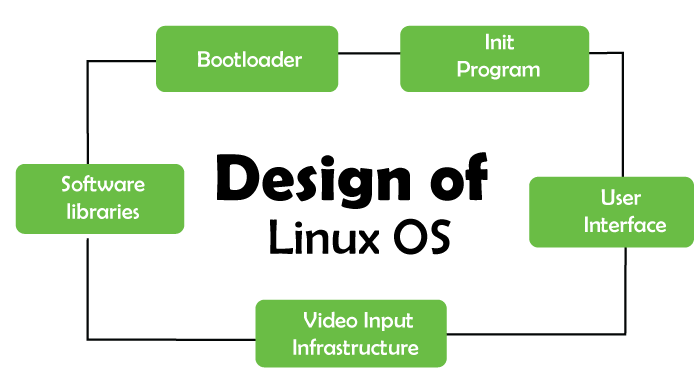Linux operating system ek modular structure par adharit hota hai, jiska matalab hai ki ismein kuch mukhya components aur layers hote hain jo alag-alag functions aur responsibilities ko handle karte hain. Niche, main Linux ke mukhya structures ko explain kar raha hoon:
Aaj iss post me janenge ki Structure of Linux O.S kya hai usme kernal kya hai, Shell kya hai, File system kya hai,Device drivers kya hai, User space kya hai, GUI(graphical user interface) kya hai, Structures of linux O.s ke Advantages kya hain, Disadvantages kya hain, Features kya kya hain, Uses kya kya hain aaj hum inn sb ko hindi me janenge.
Structures of LINUX O.S In Hindi
- Kernel (Nucleus): Linux ka core component hai, aur isme operating system ke fundamental functions hote hain. Kernel hardware resources (jaise ki CPU, memory, disk, aur peripherals) ko manage karta hai. Yeh hardware aur software ke beech communication ko handle karta hai, multitasking aur process management ki responsibility leta hai, file system ko manage karta hai, aur system calls (jaise ki file operations, memory management, network communication) ko support karta hai. Linux kernel ka source code open-source hai aur ismein continuously development hoti hai.
- Shell: Shell ek command-line interface (CLI) hai jo user aur kernel ke beech communication ke liye use hoti hai. Yeh user ke dvara diye gaye commands ko interpret karti hai aur kernel se request karti hai. Linux mein kai alag-alag shells available hain, jaise ki Bash (Bourne Again Shell), Zsh, aur Fish.
- File System: Linux me ek hierarchical file system hota hai jisme files aur directories hote hain. Ismein files aur directories ko organize kiya jata hai, aur inko access aur manage kiya jata hai. Popular Linux file systems hain Ext4, XFS, aur Btrfs.
- Device Drivers: Device drivers hardware components (jaise ki printers, graphics cards, network adapters) ke saath communication karne ke liye zaroori hote hain. Linux me device drivers kernel ke sath aate hain, aur inka main role specific hardware ko recognize aur control karna hota hai.
- User Space: User space Linux ka ek important part hai, jahan par user-level applications run hoti hain. Yeh applications kernel ke through provide ki gayi services ka use karke work karti hain. User space mein kai tarah ki applications hoti hain, jaise ki text editors, web browsers, development tools, office suites, etc.
- Libraries: Linux me libraries hoti hain jo user space applications ko help karti hain kernel aur hardware resources ka istemal karne mein. Ye libraries common functions aur APIs provide karti hain jisse developers apne applications mein use kar sakte hain. C standard library (glibc) ek aisi library hai jo bahut commonly istemal hoti hai.
- Utilities: Linux ke sath aati hai ek range ki utilities aur command-line tools jo users ko system ko manage karne aur tasks ko execute karne mein madad karti hain. Examples include ls (directory listing), cp (copy), mv (move), rm (remove), chmod (change file permissions), and more.
- Graphical User Interface (GUI): Linux me GUI desktop environments aur window managers provide kiye jate hain jinse users graphical interface ke through system ko control kar sakte hain. Popular desktop environments include GNOME, KDE, XFCE, aur LXQt.
Linux ek highly customizable aur adaptable operating system hai, jisse aap apne needs aur preferences ke hisab se configure kar sakte hain. Iska modular structure aur open-source nature isse developers ke liye bhi atrractive banata hai.

Advantages of Structures of LINUX O.S In Hindi:-
Linux operating system ke structures ke kuch mukhya advantages hain:
- Open Source: Linux ek open-source operating system hai, jiska matlab hai ki iska source code kisi bhi vyakti dwara dekha, modify, aur distribute kiya ja sakta hai. Isse users ko flexibility aur control milta hai
. - Security: Linux ka reputation security me strong hone ka hai. Isme built-in security features hote hain, jaise ki file permissions, encryption, aur network security, jo user data ko protect karte hain.
- Stability: Linux typically bahut stable hota hai aur kam crashes hoti hain. Isme kaam karne ke liye restarts ki jarurat kam hoti hai, jo productivity ko badhata hai.
- Customization: Linux me bahut sari customization options hoti hain. Users apne system ko apne according customize kar sakte hain, jaise ki desktop environment, applications, aur settings.
- Cost-Effective: Linux ka use karne ke liye koi licensing fees nahi lagti, jo dusre operating systems ke comparison me cost-effective banata hai, especially for businesses and organizations.
- Community Support: Linux ek strong community ke support me hai. Users ko online forums, documentation, aur tutorials ke through help mil sakti hai, jo problem-solving me madadgar hoti hai.
- Performance: Linux typically high performance deta hai, khas kar servers aur high-end computing me. Iska efficient resource management aur optimized code isme contribute karte hain.
- Compatibility: Linux me bahut sari applications aur hardware devices ke liye drivers aur software available hote hain, jo compatibility ko badhate hain.
Yeh advantages Linux ko ek popular choice banate hain, especially for technical users aur servers ke liye.

Disadvantages of Structures of LINUX O.S In Hindi:-
Linux ke kuch disadvantages bhi hain, jinmein se kuch niche diye gaye hain:
- Compatibility Issues: Linux ke liye kuch proprietary software aur hardware drivers available nahi hote, jo compatibility me issue create kar sakte hain.
- Learning Curve: Linux ka use karne ke liye users ko Windows ya Mac OS se thoda alag interface aur commands ko learn karna padta hai, jo beginners ke liye challenging ho sakta hai.
- Software Availability: Kuch specific applications ke liye Linux me limited software availability hoti hai. Iska matlab hai ki kuch popular software aur games Linux ke liye available nahi hote hain.
- Hardware Support: Although Linux me bahut sari hardware support hoti hai, lekin kuch new hardware devices ke liye drivers late aate hain ya phir available nahi hote, jo users ko problem create kar sakte hain.
- Fragmentation: Linux me bahut sari distributions (distros) available hain, jaise ki Ubuntu, Fedora, Debian, etc. Har distribution me thode-alag features aur interface hoti hai, jo ek user ke liye confusion create kar sakti hai.
- User Interface: Linux ka user interface (UI) kuch distributions me Windows ya Mac OS ke comparison me less polished ho sakta hai, jo kuch users ko pasand nahi aata.
- Technical Support: Although Linux me community support available hai, lekin kuch cases me professional technical support ki kami bhi ho sakti hai, especially for enterprise users.
Yeh disadvantages kuch users ke liye Linux ko less appealing banate hain, lekin overall, Linux ek powerful aur reliable operating system hai jo bahut se use cases me kaam aata hai.

Features of Structures of LINUX O.S In Hindi:-
Linux ke kuch mukhya features hain:
- Open Source: Linux ek open-source operating system hai, jiska matlab hai ki iska complete source code publically available hai. Isse users ko freedom milti hai code ko modify, distribute aur use karne ki.
- Multi-User: Linux ek multi-user operating system hai, jiska matlab hai ek hi samay me multiple users isme login kar sakte hain aur apne tasks perform kar sakte hain.
- Multi-Tasking: Linux multi-tasking support karta hai, jisse users ek hi samay me multiple applications ko run kar sakte hain aur seamlessly switch kar sakte hain.
- Security: Linux ka ek strong security model hai, jisme file permissions, user authentication, encryption aur network security features shaamil hain. Isse user data aur system ko secure rakha ja sakta hai.
- Stability: Linux typically bahut stable hai aur kam crashes hoti hain, jo isse reliable banata hai. Isme kaam karne ke liye restarts ki jarurat kam hoti hai.
- Networking: Linux ka ek powerful networking support hai, jisse users network services jaise ki file sharing, web hosting, aur network monitoring easily configure kar sakte hain.
- Flexibility: Linux me bahut sari distributions (distros) available hain, jinmein se users apne requirements ke according choose kar sakte hain. Isme customization options bhi available hain, jisse users apne system ko apne hisab se configure kar sakte hain.
- Command Line Interface: Linux ka command line interface (CLI) bahut powerful hai aur advanced users ko deep control provide karta hai. Isse users command line se tasks automate aur system ko manage kar sakte hain.
- Compatibility: Linux me bahut sari applications aur hardware devices ke liye drivers aur software available hote hain, jo compatibility ko badhate hain.
In features ki wajah se Linux ek popular choice hai developers, server administrators, aur technical users ke liye.

Uses of Structures of LINUX O.S In Hindi:-
Linux ke uses ko points mein diya ja sakta hai:
- Server Operating System: Web servers, database servers, file servers, aur email servers ke liye upyog hota hai.
- Development Environment: Software development ke liye, jisme programming languages, compilers, aur development tools available hote hain.
- Embedded Systems: Kiosks, routers, smart TVs, aur IoT devices ke liye use hota hai.
- Desktop Operating System: Desktop computers aur laptops me bhi use hota hai, khas kar non-technical users ke liye user-friendly distributions ke sath.
- Education: Schools aur universities me educational purposes ke liye use hota hai, jisse students ko programming aur computer science concepts samajhne me madad milti hai.
- Data Centers: Large-scale data centers me high-performance computing, virtualization, aur cloud computing ke liye use hota hai.
- Security Appliances: Network security appliances, firewall devices, aur intrusion detection systems ke liye upyog hota hai.
Yeh points Linux ke kuch pramukh uses ko cover karte hain.

